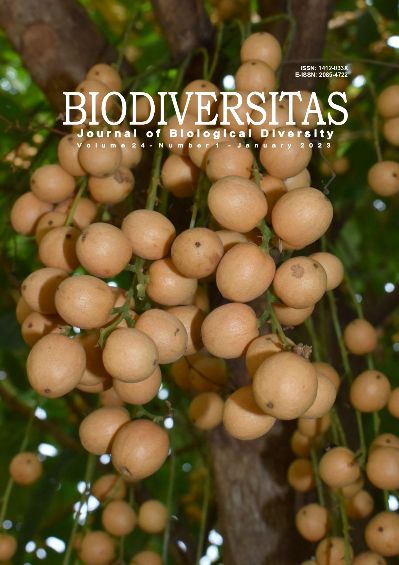Short Communication: Analysis of rhizome color and phytochemical content of 10 accessions of Curcuma zanthorrhiza Roxb. in Jambi, Indonesia
##plugins.themes.bootstrap3.article.main##
Abstract
Abstract. Minarni M, Asyhar R, Juliana D, Yudha YS, Nurcholis W. 2023. Short Communication: Analysis of rhizome color and phytochemical content of 10 accessions of Curcuma zanthorrhiza Roxb. in Jambi, Indonesia. Biodiversitas 24: 149-155. Plants are a source of secondary metabolites that have various biological functions and are beneficial for humans, particularly in the health sector. One such beneficial herbal plant, temulawak (Curcuma zanthorrhiza Roxb.), a member of the genus Curcuma L. in the Zingiberaceae family, is widely known as Javanese turmeric. C. zanthorrhiza is a potential source of drugs in the field of pharmacology. One part of temulawak that has an important role is the rhizome, commonly used in the formulation of traditional herbal medicines. There are many pharmacologically active components contained in the C. zanthorrhiza rhizome. Thus, this plant, found in many parts of Indonesia, such as Jambi and Sumatra, is worthy of detailed pharmacological investigation. The study reported in this paper aimed to determine the potential content of secondary metabolites of alkaloids, flavonoids, saponins, tannins/phenolics, and triterpenoids/steroids in 10 accessions of temulawak rhizomes in Jambi. The phytochemical content analysis in temulawak was carried out by qualitative phytochemical screening using dye reagents. Multivariate cluster analysis was carried out to determine the relationships between the 10 accessions based on similarities in the color and phytochemical content of their rhizomes. Generally, the screening results showed that the rhizomes of the 10 C. zanthorrhiza accessions contained the same intensities of alkaloids (dragendof, mayer and wagner), flavonoids, tannins/phenolics (+++) and steroid compounds (++). On the other hand, saponin and triterpenoid were not detected in the tests of rhizomes of the 10 accessions (-). The clustering analysis of the results divided the 10 local temulawak accessions into three clusters. Cluster-1 consisted of two accessions (JM and JBB), cluster-2 consisted of three accessions (JT, JPB, and JBS), and cluster-3 consisted of five accessions (JSS, JJ, JB, JBE, and JG).
##plugins.themes.bootstrap3.article.details##
Most read articles by the same author(s)
- WARAS NURCHOLIS, NURUL KHUMAIDA, MARIA BINTANG, MUHAMAD SYUKUR, GC-MS analysis of rhizome ethanol extracts from Curcuma aeruginosa accessions and their efficiency activities as anticancer agent , Biodiversitas Journal of Biological Diversity: Vol. 22 No. 3 (2021)
- JANSON CALVINDI, MUHAMAD SYUKUR, WARAS NURCHOLIS, Investigation of biochemical characters and antioxidant properties of different winged bean (Psophocarpus tetragonolobus) genotypes grown in Indonesia , Biodiversitas Journal of Biological Diversity: Vol. 21 No. 6 (2020)
- NURUL KHUMAIDA, MUHAMAD SYUKUR, MARIA BINTANG, WARAS NURCHOLIS, Phenolic and flavonoid content in ethanol extract and agro-morphological diversity of Curcuma aeruginosa accessions growing in West Java, Indonesia , Biodiversitas Journal of Biological Diversity: Vol. 20 No. 3 (2019)
- RIZKI FITRIA, DJAROT SASONGKO HAMI SENO, BAMBANG PONTJO PRIOSOERYANTO, HARTANTI, WARAS NURCHOLIS, Volatile compound profiles and cytotoxicity in essential oils from rhizome of Curcuma aeruginosa and Curcuma zanthorrhiza , Biodiversitas Journal of Biological Diversity: Vol. 20 No. 10 (2019)
- ZULFIKAR DAMARALAM SAHID, MUHAMAD SYUKUR, AWANG MAHARIJAYA, WARAS NURCHOLIS, Quantitative and qualitative diversity of chili (Capsicum spp.) genotypes , Biodiversitas Journal of Biological Diversity: Vol. 23 No. 2 (2022)
- SYARIFAH IIS AISYAH, IZZATUL MUHALLILIN, DEWI SUKMA, WARAS NURCHOLIS, The morphological and phytochemical studies on the effect of acute and recurrent irradiation in Celosia cristata seeds , Biodiversitas Journal of Biological Diversity: Vol. 20 No. 12 (2019)
- DEWI YANNY LENAWATY, DEWI SUKMA, MUHAMAD SYUKUR, DEWA NGURAH SUPRAPTA, WARAS NURCHOLIS, SYARIFAH IIS AISYAH, Increasing the diversity of marigold (Tagetes sp.) by acute and chronic chemical induced mutation of EMS (Ethyl Methane Sulfonate) , Biodiversitas Journal of Biological Diversity: Vol. 23 No. 3 (2022)
- SURYANI, ASMAUL CHUSNA AL ANSHORY, MARLIN, I MADE ARTIKA, LAKSMI AMBARSARI, WARAS NURCHOLIS, Variability total phenolic content and antioxidant activity of Curcuma zanthorrhiza and C. aeruginosa cultivated in three different locations in West Java, Indonesia , Biodiversitas Journal of Biological Diversity: Vol. 23 No. 4 (2022)
- NURLELA NURLELA, RIFAN NURFALAH, FIRA ANANDA, TAOPIK RIDWAN, AULIYA ILMIAWATI, WARAS NURCHOLIS, HIROSHI TAKEMORI, IRMANIDA BATUBARA, Variation of morphological characteristics, total phenolic, and total flavonoid in Adenostemma lavenia, A. madurense, and A. platyphyllum , Biodiversitas Journal of Biological Diversity: Vol. 23 No. 8 (2022)
- RAYANDRA ASYHAR, MINARNI MINARNI, RINI ANGGI ARISTA, WARAS NURCHOLIS, Total phenolic and flavonoid contents and their antioxidant capacity of Curcuma xanthorrhiza accessions from Jambi , Biodiversitas Journal of Biological Diversity: Vol. 24 No. 9 (2023)

